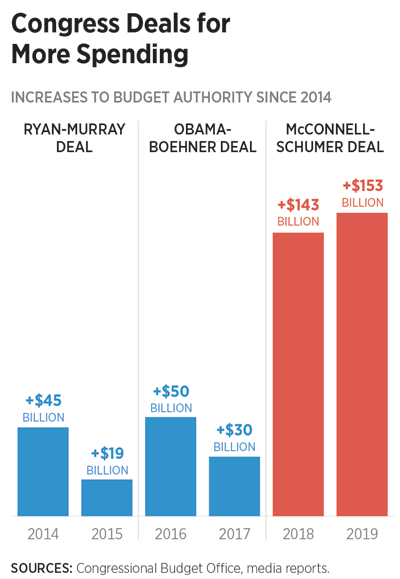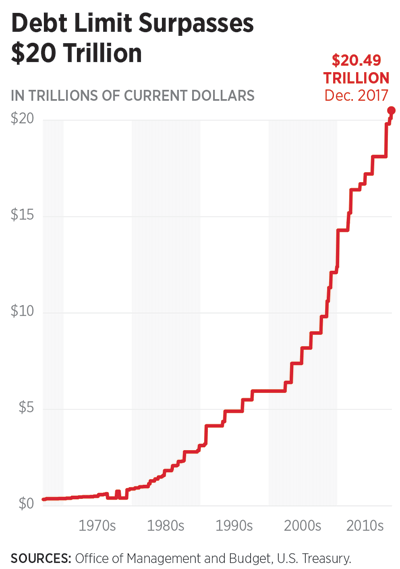- The Bipartisan Budget Act of 2018 (2018 BBA) busted the Budget Control Act spending limits, authorized additional disaster relief for areas affected by hurricanes and wildfires, and extended a large swath of special interest tax provisions.
- In total, the Congressional Budget Office estimates the 2018 BBA will increase federal deficits by $342 billion over 10 years, not including increased interest payments on the national debt.
- The 2018 BBA increased the Budget Control Act discretionary spending caps by $296 billion over the next two years.
- Unlike past budget deals, which on paper fully paid for increases in the discretionary spending limits, this deal pays for only about one-third of the new discretionary spending.
- Including $160 billion in Overseas Contingency Operations and $89.3 billion for disaster relief funds, the deal raises spending by more than a half a trillion dollars.
- The 2018 BBA authorizes an additional $165 billion for national defense in fiscal years 2018 and 2019 to begin rebuilding America’s military capabilities after several years of budget cuts. This new spending should have been fully paid for with spending reductions in bloated domestic programs.
To put the 2018 BBA spending levels in perspective:
- 2018 non-defense spending is $117 billion above President Trump’s budget request.
- The deal increases the Budget Control Act’s non-defense spending limits in 2018 by 311 percent; more than the amount President Obama requested in his final budget.
- The two-year increase in discretionary spending is larger than any single spending increase since the 2009 stimulus package.
- This deal increases total discretionary spending by more than twice the increase authorized in the previous two budget deals combined.
- The Committee for a Responsible Federal Budget estimates the 2018 BBA would add another $2 trillion to the national debt in the coming decade if the temporary provisions of this act were made permanent.[REF] That’s $16,000 per American household on top of the $162,000 in national debt that American households already owe.


- The 2018 BBA further suspends the debt limit until March 2019, giving Congress a blank check to borrow without restraint.
- Of the $89 billion in disaster relief funds, only about one third will go to FEMA for direct disaster response efforts. $28 billion would go toward Community Development Block Grant (CDBG), increasing annual CDBG funds by a factor of TK. CDBG funds are a slush fund for local pet projects and have come under scrutiny for inappropriate and wasteful spending. This is a program that the President had proposed to fully eliminate in both of the Administration’s budget submissions to Congress.
- The 2018 BBA sets up a massive fiscal cliff in 2020, when discretionary funding is scheduled to decline by $125 billion, according to the Budget Control Act. Congress will be inclined to pursue another budget deal to avoid funding reductions, setting the stage for a potential 2020 BBA.
- Congress also renewed a package of expiring tax subsides at a cost of $17 billion—many of these so-called “extenders” were only extended for one year. The tax package primarily targets the energy industry by subsidizing solar lighting systems, fuel cells, geothermal heat pumps, biofuels, nuclear power plants, and small wind power, among many other special interest provisions. Prior to Congress waiving automatic spending cuts that would have been triggered by the deficit increase from tax reform and the 2018 BBA spending increase, the Congressional Budget Office was already projecting that the debt would rise by over $10 trillion by 2027. Congress is supercharging deficits.
- Congress is spending and borrowing excessively. The high and rising national debt drags down economic growth and risks undoing the positive effects of tax reform.
- The 2018 BBA authorized new, higher limits for discretionary spending, for which funds will be appropriated in mid-March, giving fiscally responsible lawmakers another opportunity to drive spending down and eliminate duplicate, wasteful, and inappropriate federal programs.
- With only about six months left for discretionary funds to be spent before they are rescinded at the end of the 2018 fiscal year, Congress must exercise more diligent and vigorous oversight as billions of funds are at risk of being wasted by agencies trying not to “lose” the funds.
- Congress should allow every tax extender to expire and future legislation should scrub the tax code of all subsidies for privileged interests.
- To improve federal budget sustainability, Congress should commit to fiscal responsibility, before the next fiscal crisis threatens to impose severe austerity measures. A statutory spending cap that encompasses all expenditures, tied to economic growth, offers the best hope to help lawmakers recognize trade-offs in fiscal decisions and prioritize funding for the highest value federal projects, while encouraging fiscal restraint and the devolution of activities that are best managed by the private sector or by state and local government to those entities.



